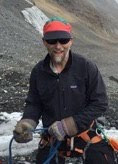Frustration.
In my polar research, I often categorize my days using the early polar explorers. On an Amundsen day, everything goes smoothly, things work, and it's all good. A Scott day means a pretty tragic day, where things break, and at the end of the day you're in a worse state than where you started the day. Today was a Shackleton day, in which I didn't manage to collect any data, but at the end of the day I'd managed to get back to the state in which I'd started the day; everyone came back alive.
The goal of the day was to log a borehole drilled by colleagues from the Cold Regions Research and Engineering Lab, about 5 km from camp. I'd been given GPS co-ordinates, but in some confusion earlier this season, the flags marking the hole had been removed. The GPS co-ordinates were taken with a handheld GPS receiver, and so were probably good to about 3 meters or so. So I brought a team of carpenters out with me and we covered the area within about 10 meters of the GPS location, using avalanche probes to penetrate the snow and try to find the plywood covering the hole:

Probing for the borehole. Photo by Chico Perales.
To make a long morning short, we didn't find anything. We're now pretty sure that somehow, at some point, the plywood covering the borehole was removed; otherwise we'd have found it with our probes, which had penetrated almost 2 meters, at a spacing of about 15 centimeters, over a 100 square meter area around the borehole location. We felt hard ice layers with the probes and thought we'd identified the area of activity where the drill had been (and feet had packed down the snow there), but no borehole.
Ok, time to shift into backup plan; there were 4 additional boreholes near this site, which were well-flagged. If I couldn't log the same hole from which my colleagues extracted the core, at least I could log one nearby.
So I set out to log the nearby holes, only to discover a major failure with the logging system. The winch simply wouldn't work. Aborting the mission, I went back to the lab to diagnose the problem. It turned out to be a wire that had simply shaken loose sometime in the previous week's travelling:

The broken wire. I managed to solder it back together, and then got the system working again. In the end, I'd returned to where I'd been that morning- no additional data, but at least the system was working correctly again, which is the most important part; this gear is used by the science technicians every month through the winter; had I not tried to do this log, I might not have discovered the broken wire, and that would have possibly cost me the winter's data collection. So in the end, what happenend today was good.


0 Comments:
Post a Comment
<< Home